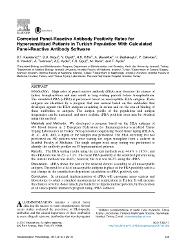| dc.contributor.author | Karadeniz, Sedat Tanju | |
| dc.contributor.author | Akgül, Sebahat Usta | |
| dc.contributor.author | Öğret, Yeliz | |
| dc.contributor.author | Çiftçi, Hayriye Şentürk | |
| dc.contributor.author | Bayraktar, Adem | |
| dc.contributor.author | Bakkaloğlu, Hüseyin | |
| dc.contributor.author | Çalışkan, Yaşar Kerem | |
| dc.contributor.author | Yelekçi, Kemal | |
| dc.contributor.author | Türkmen, Aydin | |
| dc.contributor.author | Aydın, Ali Emin | |
| dc.contributor.author | Oğuz, Fatma Savran | |
| dc.contributor.author | Çarin, Mahmut Nezih | |
| dc.contributor.author | Aydın, Filiz | |
| dc.date.accessioned | 2019-06-27T08:01:22Z | en_US |
| dc.date.available | 2019-06-27T08:01:22Z | en_US |
| dc.date.issued | 2017 | en_US |
| dc.identifier.issn | 0041-1345 | en_US |
| dc.identifier.issn | 1873-2623 | en_US |
| dc.identifier.uri | https://hdl.handle.net/20.500.12469/358 | |
| dc.identifier.uri | https://doi.org/10.1016/j.transproceed.2017.01.032 | |
| dc.description.abstract | however the rate was 86.2% using the cPRA. Discussion. cPRA shows the rate of the rejected donors according to all unacceptable antigens. The need for a list of unacceptable antigens in place of the PRA positivity rate is a real change in the sensitization-dependent calculation as cPRA positivity rate. Conclusion. In principal implementation of cPRA will encourage many centers and laboratories to adopt a standard measurement of sensitization in Turkey. It will increase the chances of better donor match particularly for hypersensitized patients by the creation of an unacceptable mismatch program using cPRA software. | en_US |
| dc.description.abstract | Introduction. High rates of panel-reactive antibody (PRA) may decrease the chance of kidney transplantation and may result in long waiting periods before transplantation. The calculated PRA (cPRA) is performed based on unacceptable HLA antigens. These antigens are identified by a program that was created based on the antibodies that developed against the HLA antigens circulating in serum and on the risk of binding of these antibodies to antigens. The antigen profile of the population and antigen frequencies can be measured and more realistic cPRA positivity rates may be obtained using this method. Materials and Methods. We developed a program based on the HLA antigens of 494 blood donors in 2 European Federation for Immunogenetics accredited Tissue Typing Laboratories in Turkey. Next-generation sequencing based tissue typing (HLA-A -B-C-DR-DQ 4 digits) of the samples was performed. The PRA screening test was performed on 380 patients who were waiting for organ transplant from a cadaver in Istanbul Faculty of Medicine. The single antigen bead assay testing was performed to identify the antibody profiles on 48 hypersensitized patients. Results. The PRA testing results using the current methods were 44.6% +/- 18.5% and the cPRA rate was 86.2% +/- 5.1%. The mean PRA positivity of the sensitized patients using the current methods was 44.6% | en_US] |
| dc.language.iso | eng | en_US |
| dc.publisher | Elsevier Science Inc | en_US |
| dc.rights | info:eu-repo/semantics/closedAccess | en_US |
| dc.subject | PRA | en_US |
| dc.subject | HLA | en_US |
| dc.subject | cPRA | en_US |
| dc.subject | Calculated PRA | en_US |
| dc.subject | Next Generation Sequencing | en_US |
| dc.subject | Hesaplamalı PRA | en_US |
| dc.subject | Yeni Nesil Dizileme | en_US |
| dc.title | Corrected Panel-Reactive Antibody Positivity Rates for Hypersensitized Patients in Turkish Population With Calculated Panel-Reactive Antibody Software | en_US |
| dc.type | article | en_US |
| dc.identifier.startpage | 445 | en_US |
| dc.identifier.endpage | 447 | en_US |
| dc.relation.journal | Transplantation Proceedings | en_US |
| dc.identifier.issue | 3 | en_US |
| dc.identifier.volume | 49 | en_US |
| dc.department | Fakülteler, Mühendislik ve Doğa Bilimleri Fakültesi, Biyoinformatik ve Genetik Bölümü | en_US |
| dc.identifier.wos | WOS:000398017900013 | en_US |
| dc.identifier.doi | 10.1016/j.transproceed.2017.01.032 | en_US |
| dc.identifier.scopus | 2-s2.0-85015944507 | en_US |
| dc.institutionauthor | Yelekçi, Kemal | en_US |
| dc.relation.publicationcategory | Makale - Uluslararası Hakemli Dergi - Kurum Öğretim Elemanı | en_US |
| dc.identifier.pmid | 28340809 | en_US |
















